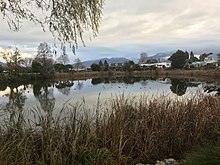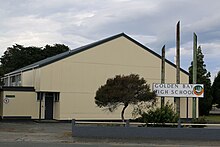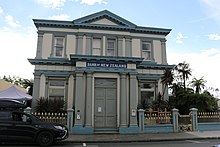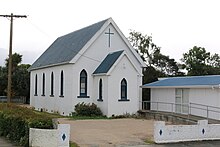Takaka
History
The area has long had Māori settlement. An early nation is Ngāti Tumatakōkiri, then Ngāti Apa and today the iwi are known as Manawhenua ki Mohua Ngāti Tama, Ngāti Rarua and Te Āti Awa, these nations (iwi) migrating from the North Island in the 1820s.
The name of the town may derive from Taha'a island in the Society Islands in French Polynesia. A local myth about a taniwha in the nearby Parapara River is similar to one told about the Parapara strait, which separates Taha'a from Motue'a island.
From 1853 to 1876, Tākaka was administered as part of the Nelson Province. Sawmilling was an important business for Tākaka in the 1870s. The Takaka tramway was built in 1880. Prior to that time timber was transported to the port by teams of bullocks which would often leave the main street of Tākaka looking like a rutted bog. After flooding in 1904 did significant damage to the tramway, it was sold in 1905 and the locomotive, rolling stock and rails were shipped to Onehunga by sea.
Tākaka contributed soldiers to the Boer War, the First World War and the Second World War with 1, 44 and 25 respectively dying in each conflict.
Onetahua Kokiri Marae (Manawhenua ki Mohua) in Pohara Valley was established in 1986, used a re-purposed school in 1992 and in 2001 a meeting house named Te Ao Marama was opened. The name comes from the name for Farewell Spit. Te Ātiawa te Waka a Māui state that "Onetahua connects ancestrally to the waka Tokomaru, the maunga Parapara and the awa Waikoropupu".
In June 2005, much of the town was temporarily evacuated after fire swept through Tākaka's biggest industrial complex, a dairy factory. There were fears that volatile chemicals stored at the plant might explode, leading to the release of poisonous gases, which later proved to be unfounded.
In July 2020, the name of the town was officially gazetted as Tākaka by the New Zealand Geographic Board.
Geography

The area around Tākaka Hill is dominated by its karst geology. This creates sinkholes and cave systems, including New Zealand's deepest vertical shaft, Harwoods Hole. Lake Killarney in Tākaka is a sinkhole filled with groundwater.
Tākaka and Golden Bay are known for rock climbing, particularly around the area of Paines Ford.
The town is also known for Te Waikoropupū Springs (colloquially known as Pupu Springs).
The antipode of Tākaka is the town of Coriscada, Portugal.
Climate
Tākaka is one of the warmest locations in the South Island, due to its northerly position and maritime influences from the Golden Bay. Because of the hills in the Kahurangi National Park to the south-west of Tākaka, the town receives substantially less rainfall than the West Coast. Tākaka's location on the leeward side of these hills allow the wind to become warmer and drier as it flows down towards the town, allowing an average of 22 days a year to exceed 26.7 °C (80 °F). On the contrary, being a few kilometres inland, cold air can settle over Tākaka on winter mornings, resulting in an average of 17.2 frosty days per year.
| Climate data for Takaka (1991–2020) | |||||||||||||
|---|---|---|---|---|---|---|---|---|---|---|---|---|---|
| Month | Jan | Feb | Mar | Apr | May | Jun | Jul | Aug | Sep | Oct | Nov | Dec | Year |
| Mean daily maximum °C (°F) | 23.4 (74.1) |
23.3 (73.9) |
21.4 (70.5) |
18.8 (65.8) |
16.5 (61.7) |
14.2 (57.6) |
13.4 (56.1) |
14.0 (57.2) |
15.7 (60.3) |
17.8 (64.0) |
19.4 (66.9) |
21.5 (70.7) |
18.3 (64.9) |
| Daily mean °C (°F) | 17.4 (63.3) |
17.4 (63.3) |
15.7 (60.3) |
13.3 (55.9) |
10.9 (51.6) |
8.6 (47.5) |
7.9 (46.2) |
8.6 (47.5) |
10.2 (50.4) |
12.1 (53.8) |
13.8 (56.8) |
16.1 (61.0) |
12.7 (54.8) |
| Mean daily minimum °C (°F) | 11.4 (52.5) |
11.6 (52.9) |
10.0 (50.0) |
7.8 (46.0) |
5.4 (41.7) |
3.1 (37.6) |
2.4 (36.3) |
3.3 (37.9) |
4.7 (40.5) |
6.5 (43.7) |
8.2 (46.8) |
10.7 (51.3) |
7.1 (44.8) |
| Average rainfall mm (inches) | 141.8 (5.58) |
106.0 (4.17) |
133.8 (5.27) |
164.3 (6.47) |
178.5 (7.03) |
201.2 (7.92) |
178.2 (7.02) |
185.8 (7.31) |
180.7 (7.11) |
209.6 (8.25) |
144.2 (5.68) |
191.0 (7.52) |
2,015.1 (79.33) |
| Mean monthly sunshine hours | 251.6 | 223.4 | 213.6 | 174.4 | 163.6 | 143.3 | 156.9 | 171.7 | 183.9 | 221.5 | 237.5 | 225.7 | 2,367.1 |
| Mean daily daylight hours | 14.7 | 13.7 | 12.3 | 11.0 | 9.9 | 9.3 | 9.6 | 10.6 | 11.8 | 13.2 | 14.4 | 15.1 | 12.1 |
| Percent possible sunshine | 55 | 58 | 56 | 53 | 53 | 51 | 53 | 52 | 52 | 54 | 55 | 48 | 53 |
| Source 1: NIWA | |||||||||||||
| Source 2: Weather Spark | |||||||||||||
Economy
Farming, sawmilling, limestone quarrying and tourism are major local industries. The area around Tākaka is mineral-rich, with gold, iron ore, copper, silver and asbestos all found locally, although not all in commercially viable amounts.
Dairy factory

There is also a small Fonterra factory located in the township of Tākaka that produces skim milk powder. There are 83 dairy farms supplying the factory, which can process about 525,000 litres (139,000 US gal) a day into skim milk powder. Cream is produced as a by-product, and is shipped to the Clandeboye factory for further processing. The $80 million Takaka dairy factory was damaged by a fire in 2005. More than 60 firefighters battled the fire, which was caused by contractors completing welding work. It has subsequently been rebuilt. In 2009, it was reported that it employed nearly 50 staff and contributed $3 million in wages to the local economy.
Demographics
Tākaka covers 12.52 km (4.83 sq mi) and had an estimated population of 1,420 as of June 2024, with a population density of 113 people per km.
| Year | Pop. | ±% p.a. |
|---|---|---|
| 2006 | 1,152 | — |
| 2013 | 1,236 | +1.01% |
| 2018 | 1,335 | +1.55% |
| Source: | ||
Tākaka had a population of 1,335 at the 2018 New Zealand census, an increase of 99 people (8.0%) since the 2013 census, and an increase of 183 people (15.9%) since the 2006 census. There were 552 households, comprising 657 males and 678 females, giving a sex ratio of 0.97 males per female. The median age was 47.0 years (compared with 37.4 years nationally), with 222 people (16.6%) aged under 15 years, 189 (14.2%) aged 15 to 29, 621 (46.5%) aged 30 to 64, and 306 (22.9%) aged 65 or older.
Ethnicities were 94.8% European/Pākehā, 10.8% Māori, 1.1% Pasifika, 2.0% Asian, and 2.5% other ethnicities. People may identify with more than one ethnicity.
The percentage of people born overseas was 18.4, compared with 27.1% nationally.
Although some people chose not to answer the census's question about religious affiliation, 64.5% had no religion, 24.9% were Christian, 0.2% were Hindu, 1.1% were Buddhist and 1.8% had other religions.
Of those at least 15 years old, 177 (15.9%) people had a bachelor's or higher degree, and 243 (21.8%) people had no formal qualifications. The median income was $24,800, compared with $31,800 nationally. 90 people (8.1%) earned over $70,000 compared to 17.2% nationally. The employment status of those at least 15 was that 483 (43.4%) people were employed full-time, 219 (19.7%) were part-time, and 27 (2.4%) were unemployed.
Education

Golden Bay High School is a co-educational state intermediate and high school for Year 7 to 13 students, with a roll of 321 as of November 2024.
There are two primary schools for Year 1 to 6 students: Tākaka Primary School, with a roll of 140, and Central Takaka School with a roll of 46.
There is also a primary school in nearby Motupipi.
Features
Golden Bay Museum – Te Waka Huia o Mohua

The Golden Bay Museum – Te Waka Huia o Mohua has displays on Abel Tasman's 1642 encounter with Ngāti Tūmatakōkiri (the local Māori tribe), Golden Bay's industrial past, and a pilot whale skeleton. It opened in 1990 after a fundraising effort by the community purchased the collections of the privately owned Takaka Museum. The current museum is owned and funded by Tasman District Council and operated by the Golden Bay Museum Society Inc.
Labyrinth Rocks Park

The Labyrinth Rocks Park is located on Scott Road. It is a two-hectare (4.9-acre) natural rock maze. Shaped by the chemistry of rainfall and rock, it is a part of the Takaka Hill karst landscape of sculptured rocks, corrugated walls and vertical clefts. Narrow passages lead to small groves of native bush or to another passage or to a dead end, but the maze is too small to get lost in. Doll figurines and toy dinosaurs poked into crevices add to the labyrinth's fairytale Jurassic Park experience. Founded by an English geologist, Dave Whittaker, it is now a public reserve. Entrance is free.
Paines Ford swimming hole and rock climbing

Paines Ford (also known as Paynes Ford) is a swimming hole and rock climbing spot on the confluence of the Waingara and Takaka rivers. An easy trail from the carpark follows the route of a tramline, that existed to haul timber out of the surrounding forest in the early 1880s, to a number of swimming holes surrounded by limestone rock formations. The entrance and carpark is located at 1886 Takaka Valley, Highway SH60, which is 3 kilometres (1.9 mi) south of central Takaka. Alternatively, it is about a 20 minutes walk from Tākaka. Paines Ford has over 200 bolted climbs. The most famous climb is 1080 and the letter G because of its unique "no-hands-rest" at the top and its views of Golden Bay.
Notable buildings
Masonic lodge

The Masonic lodge was originally built as a cinema in 1926 outside the town boundary, as for reasons unknown, a cinema was not permitted in the town. It was a popular addition to the town before being sold in 1937 and became the Masonic lodge. The Collingwood Lodge and the Takaka Lodge merged in 1972 became the Golden Bay Lodge No 144.
Golden Bay theatre
The Golden Bay theatre was opened in May 1927. Electricity became available in 1929 with a petrol engine used prior to this to provide power. When television arrived, theatre numbers declined and it was used for other public functions. In 1978 it was converted into a cafe and art gallery.

Bank of New Zealand

The Bank of New Zealand first engaged in business in Tākaka in 1884 based in a local hotel. The bank moved into the premises pictured in 1915. The building was built out of reinforced concrete supplied by the Golden Bay Cement Company. Gas lighting was initially used and this was replaced with electric lighting in 1930. The bank survived the Murchison earthquake of 1929 without any structural damage. In 1983 floods entered the bank but did little damage. The building is currently used as an art gallery.
Golden Bay Electricity Board building

On this site in Commercial Street was originally a blacksmith. In 1929, the Golden Bay Electricity Board opened the building and occupied it until 2000. It is now occupied by the Department of Conservation.
Telegraph Hotel

The Telegraph Hotel was built over 100 years ago.
Church of the Epiphany

The Anglican church of the Epiphany is situated on Commercial Street. It was consecrated by the Bishop of Nelson in 1884. It was built from locally sawn matai and totara timber. A bell tower was added in 1900 and by 1960 the timber was covered in stucco. The bell tower was replaced in 1966 and the church was extended in 2002.
Sacred Heart Catholic Church

The Church of the Sacred Heart was designed by Nelson architect Arthur Griffin, and built at a cost of £1250 using locally sourced marble. It was formally opened on 15 September 1918. The church requires structural strengthening to bring it up to the building code requirements and has not been used since 2011.
St Andrew's Presbyterian Church

St Andrew's is located on Commercial Street, Tākaka.
Eureka boarding house

The Eureka boarding house was built in 1906. A milk bar was added to the front of the building in the 1950s. It has since been modified further to provide more shop frontage.
Golf course
The Takaka Golf Club had a number of homes on local farms before shifting to Crown land at Clifton that was able to be rented for a token amount in perpetuity in 1959.
References
- ^ "ArcGIS Web Application". statsnz.maps.arcgis.com. Retrieved 29 April 2024.
- ^ "Aotearoa Data Explorer". Statistics New Zealand. Retrieved 26 October 2024.
- ^ "Historic Golden Bay". Golden Bay / Mohua.
- ^ Anderson, Atholl (2015). "Ancient Origins, 3000 BC – AD 1300". In Anderson, Atholl; Binney, Bridget; Harris, Aroha (eds.). Tangata whenua : a history. Wellington, New Zealand: Bridget Williams Books. p. 30. ISBN 9780908321537.
- ^ Signage in Commercial Street, Takaka detailing the history of the tramway (2021)
- ^ "Search the List | Waitapu Road Tramline | Heritage New Zealand". www.heritage.org.nz. Retrieved 1 February 2021.
- ^ "The Tramway and the First Bridge at Paynes Ford | NZETC". nzetc.victoria.ac.nz. Retrieved 1 February 2021.
- ^ Tākaka War Memorial, Commercial Street, Tākaka. Cited 2021
- ^ "Onetahua (Takaka)". Maori Maps. Retrieved 12 February 2024.
- ^ "Onetahua Marae". Te Ātiawa o Te Waka-a-Māui. Retrieved 12 February 2024.
- ^ "Notice of approved official geographic names" (PDF). New Zealand Gazette. 16 July 2020. Retrieved 25 July 2020.
- ^ Hindmarsh, Nina (18 May 2016). "Expert warns of safety risk from Golden Bay Recreation Centre 'sinkhole'". Stuff. Retrieved 13 January 2024.
- ^ James, Trevor; McCallum, Jonathan. River Water Quality in Tasman District 2015 (PDF) (Report). Tasman District Council. pp. 235–236. ISBN 978-0-9941001-9-1.
- ^ "Paynes Ford | ClimbNZ | climbnz.org.nz". climbnz.org.nz. Retrieved 25 July 2021.
- ^ "World famous in New Zealand: Te Waikoropupū Springs, Takaka". Stuff. 17 November 2018. Retrieved 25 July 2021.
- ^ "CliFlo – National Climate Database : Takaka Ews". NIWA. Retrieved 19 May 2024.
- ^ "Climate and Average Weather Year Round in Takaka". Weather Spark. Retrieved 10 December 2024.
- ^ "Big dry a big earner for region". Stuff. 31 August 2009. Retrieved 31 January 2021.
- ^ Malthus, Nigel. "Down to the sea in barges". ruralnewsgroup.co.nz. Retrieved 31 January 2021.
- ^ "Welding caused milk factory fire, inquiry finds". NZ Herald. Retrieved 31 January 2021.
- ^ "Fonterra to begin rebuilding Takaka factory". NZ Herald. Retrieved 31 January 2021.
- ^ "Big dry a big earner for region". Stuff. 31 August 2009. Retrieved 31 January 2021.
- ^ "Statistical area 1 dataset for 2018 Census". Statistics New Zealand. March 2020. Takaka (300500). 2018 Census place summary: Takaka
- ^ "Golden Bay High School Official School Website". gbh.school.nz.
- ^ "Golden Bay High School Ministry of Education School Profile". educationcounts.govt.nz. Ministry of Education.
- ^ "Golden Bay High School Education Review Office Report". ero.govt.nz. Education Review Office.
- ^ "Takaka Primary School Official School Website". takakaprimary.school.nz.
- ^ "Takaka Primary School Ministry of Education School Profile". educationcounts.govt.nz. Ministry of Education.
- ^ "Takaka Primary School Education Review Office Report". ero.govt.nz. Education Review Office.
- ^ "Ministry of Education School Profile". educationcounts.govt.nz. Ministry of Education.
- ^ "Education Review Office Report". ero.govt.nz. Education Review Office.
- ^ "Motupipi Primary School Ministry of Education School Profile". educationcounts.govt.nz. Ministry of Education.
- ^ "Golden Bay Museum". Golden Bay Museum.
- ^ "Golden Bay Museum on Kōtuia". kotuia.org.nz. Te Papa.
- ^ "Best things to see and do in Takaka". NZ Herald. Retrieved 17 June 2021.
- ^ "Walks in Golden Bay, choose a walk to suit you". www.goldenbaynz.co.nz. Retrieved 17 June 2021.
- ^ Simpson, Philip (2018). Down the Bay: a natural and cultural history of Abel Tasman National Park. Nelson: Potton & Burton. p. 214. ISBN 9780947503932.
- ^ "Labyrinth Rocks Park Attractions & Activities in Golden Bay & Takaka New Zealand". NelsonTasman.NZ. Retrieved 1 January 2024.
- ^ "Treedragon's Home Page". labyrinthsculptures.co.nz. Retrieved 1 January 2024.
- ^ "Labyrinth Rocks to become public reserve". Stuff. 31 January 2009. Retrieved 1 January 2024.
- ^ "Drifting through Golden Bay's waters". Stuff. 25 January 2018. Retrieved 31 January 2021.
- ^ "Paines Ford Tramline Track". www.doc.govt.nz. Retrieved 31 January 2021.
- ^ "Peeling back the colourful past of Takaka's Masonic Hall". Stuff. 3 September 2021. Retrieved 9 October 2021.
- ^ "About us". The Wholemeal Cafe. Retrieved 25 July 2021.
- ^ "Search the List | Bank of New Zealand | Heritage New Zealand". www.heritage.org.nz. Retrieved 25 July 2021.
- ^ Signage in Commercial Street. Heritage Golden Bay Inc Installed 2015 Cited 2021
- ^ "Challenging times at the local". Stuff. 31 January 2009. Retrieved 1 February 2021.
- ^ Signage outside the church. Heritage Golden Bay inc. published 2015. Cited 2021
- ^ "Golden Bay Anglican Parish – Home Page". www.goldenbayanglican.nz. Retrieved 25 July 2021.
- ^ Addison, Paul (2019). "Provincial architect with a competitive edge: Arthur Griffin, the early years". Architectural History Aotearoa. 16: 16–23. doi:10.26686/aha.v16.8851.
- ^ "New Church of the Sacred Heart, Takaka". New Zealand Tablet. 3 October 1918. p. 13. Retrieved 14 January 2024.
- ^ "Takaka". Our Lady of the Bays. Retrieved 1 February 2021.
- ^ "Takaka – St Andrew's Presbyterian Church | Presbyterian Church of Aotearoa New Zealand". www.presbyterian.org.nz. Retrieved 9 October 2021.
- ^ Signage in Takaka. Heritage Golden Bay Inc. Published 2013. Cited 2021
- ^ "Club History". Takaka Golf Club. Retrieved 5 November 2021.